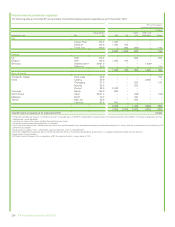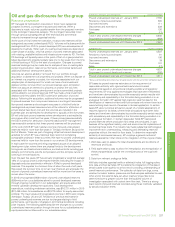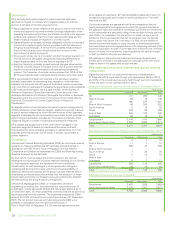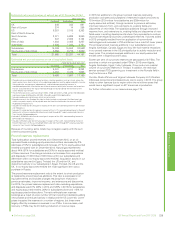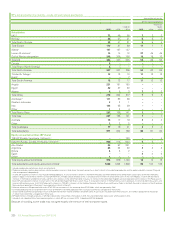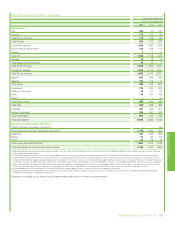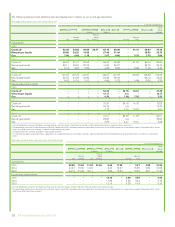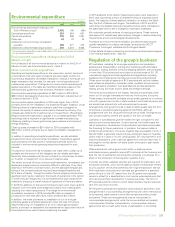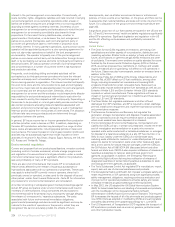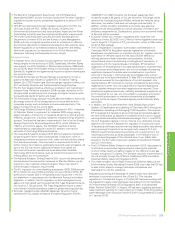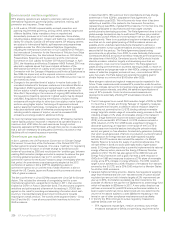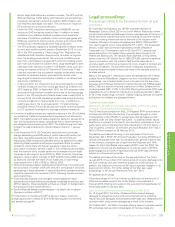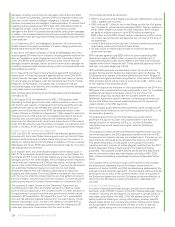BP 2015 Annual Report Download - page 232
Download and view the complete annual report
Please find page 232 of the 2015 BP annual report below. You can navigate through the pages in the report by either clicking on the pages listed below, or by using the keyword search tool below to find specific information within the annual report.
Governance
BP’s centrally controlled process for proved reserves estimation
approval forms part of a holistic and integrated system of internal
control. It consists of the following elements:
• Accountabilities of certain officers of the group to ensure that there is
review and approval of proved reserves bookings independent of the
operating business and that there are effective controls in the approval
process and verification that the proved reserves estimates and the
related financial impacts are reported in a timely manner.
• Capital allocation processes, whereby delegated authority is exercised
to commit to capital projects that are consistent with the delivery of
the group’s business plan. A formal review process exists to ensure
that both technical and commercial criteria are met prior to the
commitment of capital to projects.
• Group audit, whose role is to consider whether the group’s system of
internal control is adequately designed and operating effectively to
respond appropriately to the risks that are significant to BP.
• Approval hierarchy, whereby proved reserves changes above certain
threshold volumes require immediate review and all proved reserves
require annual central authorization and have scheduled periodic
reviews. The frequency of periodic review ensures that 100% of the
BP proved reserves base undergoes central review every three years.
BP’s vice president of segment reserves is the petroleum engineer
primarily responsible for overseeing the preparation of the reserves
estimate. He has more than 30 years of diversified industry experience
with more than 10 years spent managing the governance and compliance
of BP’s reserves estimation. He is a past member of the Society of
Petroleum Engineers Oil and Gas Reserves Committee and of the
American Association of Petroleum Geologists Committee on Resource
Evaluation and is the current chair of the bureau of the United Nations
Economic Commission for Europe Expert Group on Resource
Classification.
No specific portion of compensation bonuses for senior management is
directly related to proved reserves targets. Additions to proved reserves
is one of several indicators by which the performance of the Upstream
segment is assessed by the remuneration committee for the purposes of
determining compensation bonuses for the executive directors. Other
indicators include a number of financial and operational measures.
BP’s variable pay programme for the other senior managers in the
Upstream segment is based on individual performance contracts.
Individual performance contracts are based on agreed items from the
business performance plan, one of which, if chosen, could relate to
proved reserves.
Compliance
International Financial Reporting Standards (IFRS) do not provide specific
guidance on reserves disclosures. BP estimates proved reserves in
accordance with SEC Rule 4-10 (a) of Regulation S-X and relevant
Compliance and Disclosure Interpretations (C&DI) and Staff Accounting
Bulletins as issued by the SEC staff.
By their nature, there is always some risk involved in the ultimate
development and production of proved reserves including, but not limited
to: final regulatory approval; the installation of new or additional
infrastructure, as well as changes in oil and gas prices; changes in
operating and development costs; and the continued availability of
additional development capital. All the group’s proved reserves held in
subsidiaries and equity-accounted entities with the exception of those
proved reserves held by our Russian equity-accounted entity, Rosneft,
are estimated by the group’s petroleum engineers.
DeGolyer & MacNaughton (D&M), an independent petroleum
engineering consulting firm, has estimated the net proved crude oil,
condensate, natural gas liquids (NGLs) and natural gas reserves, as of
31 December 2015, of certain properties owned by Rosneft as part of our
equity-accounted proved reserves. The properties evaluated by D&M
account for 100% of Rosneft’s net proved reserves as of 31 December
2015. The net proved reserves estimates prepared by D&M were
prepared in accordance with the reserves definitions of
Rule 4-10(a)(1)-(32) of Regulation S-X. All reserves estimates involve
some degree of uncertainty. BP has filed D&M’s independent report on
its reserves estimates as an exhibit to its Annual Report on Form 20-F
filed with the SEC.
Our proved reserves are associated with both concessions (tax and
royalty arrangements) and agreements where the group is exposed to
the upstream risks and rewards of ownership, but where our entitlement
to the hydrocarbons is calculated using a more complex formula, such as
with PSAs. In a concession, the consortium of which we are a part is
entitled to the proved reserves that can be produced over the licence
period, which may be the life of the field. In a PSA, we are entitled to
recover volumes that equate to costs incurred to develop and produce
the proved reserves and an agreed share of the remaining volumes or the
economic equivalent. As part of our entitlement is driven by the monetary
amount of costs to be recovered, price fluctuations will have an impact
on both production volumes and reserves.
We disclose our share of proved reserves held in equity-accounted
entities (joint ventures*and associates*), although we do not control
these entities or the assets held by such entities.
BP’s estimated net proved reserves and proved reserves
replacement
Eighty-four per cent of our total proved reserves of subsidiaries at
31 December 2015 were held through joint operations*(84% in 2014),
and 34% of the proved reserves were held through such joint operations
where we were not the operator (33% in 2014).
Estimated net proved reserves of crude oil at 31 December 2015abc
million barrels
Developed Undeveloped Total
UK 141 298 440
Rest of Europe 86 19 106
US 890 577 1,467
Rest of North America 46 205 252
South America 8 18 26
Africa 340 89 429
Rest of Asia 598 192 790
Australasia 35 16 51
Subsidiaries*2,146 1,414 3,560
Equity-accounted entities 3,225 2,292 5,517
Total 5,371 3,707 9,078
Estimated net proved reserves of natural gas liquids at 31 December 2015
ab
million barrels
Developed Undeveloped Total
UK 5 4 10
Rest of Europe 11 1 12
US 269 70 339
Rest of North America – – –
South America 7 28 35
Africa 5 10 15
Rest of Asia – – –
Australasia 9 2 12
Subsidiaries 308 115 422
Equity-accounted entities 45 15 60
Total 352 130 482
Estimated net proved reserves of liquids*
million barrels
Developed Undeveloped Total
Subsidiaries 2,453 1,529 3,982de
Equity-accounted entities 3,270 2,307 5,577f
Total 5,723 3,836 9,560
228 BP Annual Report and Form 20-F 2015










